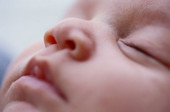
MONDAY, June 27 (HealthDay News) — New mandatory safety standards for cribs in the United States that take effect Tuesday “are an important step in ensuring a safe environment for infants as they sleep,” according to a statement from the National Institute of Child Health and Human Development.
Under the new Consumer Product Safety Commission rules, the manufacture and sale of dangerous drop side cribs will be banned, mattress supports will be stronger, crib hardware more durable, and safety testing of cribs will be more rigorous, Yvonne T. Maddox, deputy director of the institute, said in the statement released Monday.
Since 2000, drop side cribs have been linked to at least 32 infant deaths in the United States, according to the CPSC. Problems with the cribs can cause infants to become trapped in a gap between the crib mattress and drop side rails, resulting in suffocation.
Along with the new crib standards, there are several steps parents and caregivers can take to ensure a safe sleep environment for infants, Maddox said in the statement:
- Always place an infant on his or her back to sleep.
- Place infants on a firm sleep surface, such as a safety-approved crib mattress with a fitted sheet. Never place infants on a soft surface such as a pillow, quilt or sheepskin.
- All soft objects — such as pillows, cushioned crib bumpers, toys, and loose bedding — should be kept out of an infant’s sleep area.
- Infants should not share a bed with adults or other children and an infant’s crib or basinet should be placed in the parents’ bedroom, the American Academy of Pediatrics recommends.
More information
The American Academy of Pediatrics offers a guide to safe infant sleep.

